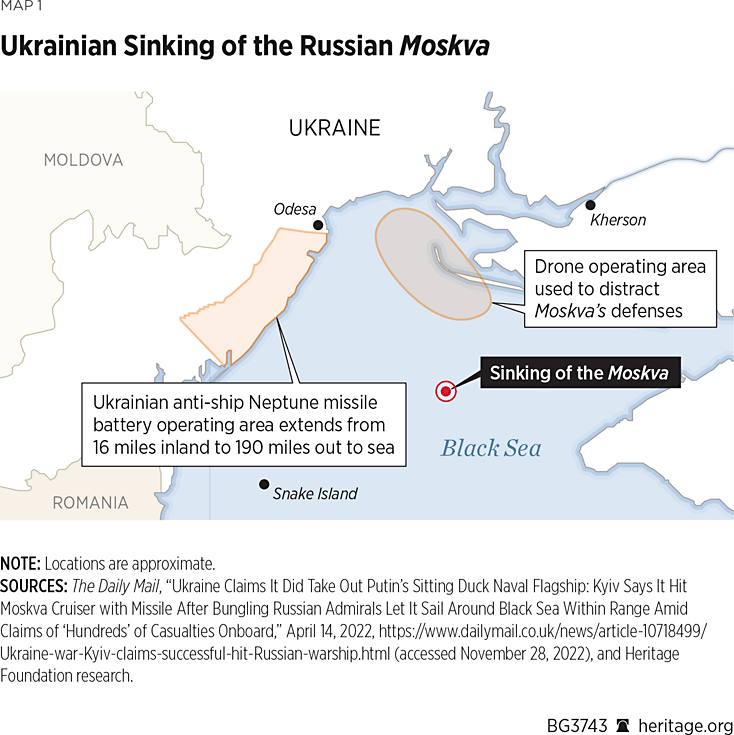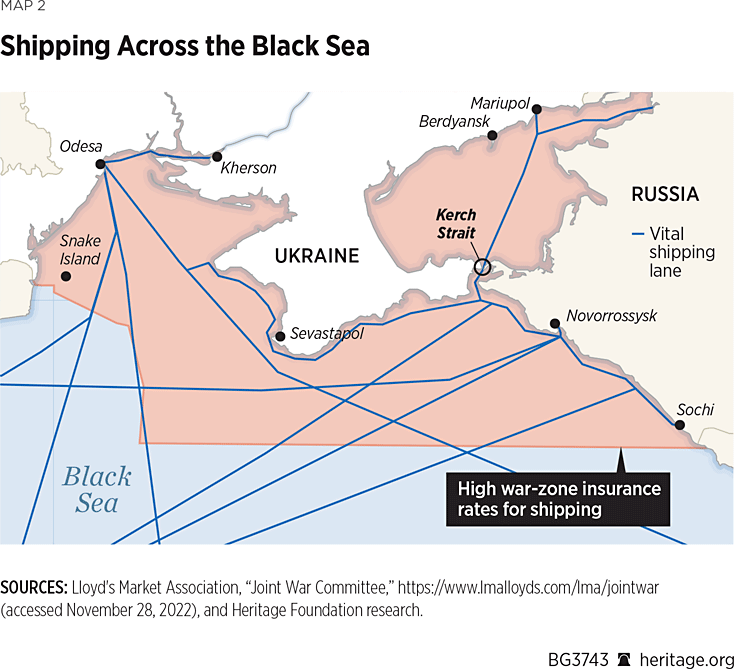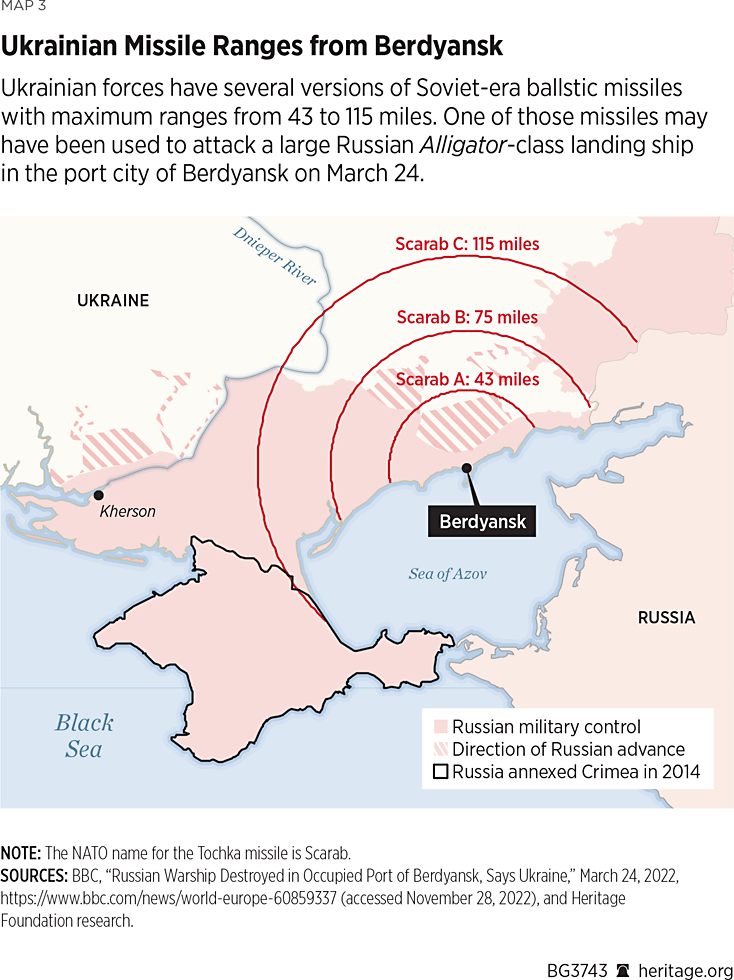The naval war between Ukraine and Russia offers important insights for a potential U.S. fight with China, likely over Taiwan. Most critically, Ukraine’s ability to blunt Russia’s initial attack has not been lost on Taipei or Washington, and Russia’s lackluster naval performance is a reminder to not take naval dominance for granted. Fundamentally, the U.S. must help make a Chinese invasion of Taiwan too costly, while sharpening its own readiness for modern naval warfare at a scale not seen since World War Two.
To do this, the U.S. Navy must learn from the war fought on the Black Sea between Russia and Ukraine and act on several key insights it provides regarding conduct of modern naval warfare. A few examples include the importance and prevalence of unmanned systems in naval conflict. This was noted in the assault on Sevastopol in October 2022 and the sinking of the cruiser Moskva in April 2022. Additionally, shore-based anti-ship weapons have demonstrated their utility and effectiveness for any future naval conflict.
Active combat offers rare insights, but since the fighting is ongoing, this is a work in progress. Taking stock now, however, will help ensure that key observations that can inform future naval warfare are not lost.
Lastly, without these insights, there would almost certainly be missed opportunities, and errors would be repeated in any future naval conflict—notably one over Taiwan. With that in mind, this paper will provide several recommendations.
Parallels Between the War in Ukraine and a War with China
To better identify and frame insights of the ongoing naval war in the Black Sea, it is helpful to consider several key operational problems confronting naval forces in the Black Sea that would also shape a conflict over Taiwan. (A key operational problem is a military action important to eventual success in conflict.) In the context of Taiwan these include:
Blunt and Deny. Blunting an attacker’s initial assault denies them a rapid victory. In the lead-up to Russia’s invasion of Ukraine, conventional wisdom said that the Russians would win in days. Due to Ukrainian tenacity, and the important assistance of Western weapons and training,REF this did not occur. Notable weapons that blunted Russia’s armored and air advantage include hundreds of man-portable anti-air Stinger missiles and thousands of anti-tank Javelin missiles.REF Had Russia been more successful militarily early on, and had Ukrainian resistance faltered, it is doubtful that the billions of dollars in additional military aid, including long-range weapon systems to turn the tide of the conflict, would have been delivered. This is a lesson being taken seriously in Taipei and Tokyo should a war with China erupt.REF
Sustain. Sustaining the flow of critical armaments and supplies is critical in a major war. Before the February 2022 invasion, over 70 percent of Ukraine’s trade was conducted via Black Sea shipping from ports such as Odesa and now Russian-occupied Mariupol.REF Wars like this impact more than just belligerents, and these effects can add pressure on the overall war effort. For example, the world pressured Russia to relax its naval blockade and allow much-needed Ukrainian grain exports. (Of course, Russia benefited too from this deal, with its own considerable grain exports.) And similarly, in a war over Taiwan, the U.S. and many allied nations would be cut off from a major source of micro-electronics sourced from Taiwan.REF Being cut off from hard-to-replace imports can bring industry to a standstill, as has been seen with the auto industry’s chip shortage—supply could not keep up as demand returned as the COVID-19 pandemic subsided in late 2021. Additionally, unlike the situation in Ukraine, a lack of overland options for resupply would make sustaining Taiwan’s resistance to a Chinese attack complicated.
Maneuver Advantage. While there has been no Russian amphibious invasion (despite Russia having the necessary forces and training), smaller amphibious assaults have proven effective at securing important geographic points (e.g., Snake Island) and for maneuver warfare (e.g., logistic landings near Mariupol). In the case of a war with Taiwan, amphibious warfare would likely involve securing offshore islands as part of a blockade and eventually an amphibious invasion. Beginning in Spring 2021, Russia exercised large amphibious landings on the Kerch peninsula of Crimea in what was considered a dress-rehearsal for a later invasion.REF Because of this, an amphibious assault in the days leading up to the February invasion was considered a high likelihood.REF Although there has been no large-scale Russian amphibious invasion, this is not to say that these forces served no utility; they likely fixed Ukrainian forces in Odesa away from frontlines to the north and east.REF All told, Russian and Chinese militaries appreciate the complexity and risk of executing a large amphibious assault onto a contested beachhead, which is not to say that China and Russia rule out such operations.
Black Sea Naval Battle Insights
With the above key operational problems in mind, here are seven key observations of the naval war in the Black Sea:
- Land-based anti-ship cruise missiles in coordinated attacks can overcome advanced warship defenses. The most notable occurrence of this was the coordinated April 14, 2022, attack and sinking of Russia’s Black Sea flagship Moskva. The ship’s significant defenses were overcome using Bayraktar TB2 drones to distract and target the ship, allowing two Neptune land-based anti-ship cruise missiles to slip past the ship’s defenses.REF The Russian crew was likely lured into steering its Volna 3R41 Top Dome fire control radar to engage the drones and not the incoming Neptune missiles. More modern radars, such as the U.S. Aegis system, would be less susceptible to such an attack, having been designed to conduct 360-degree, near-persistent searches using digital technologies. Yet, there is a risk that even these advanced U.S. naval systems could be overwhelmed by swarms of drones and naval crews and ship’s defenses stressed by multi-axis attacks.
- Resilient ship design and crew training to survive battle damage remain important. The loss of the Moskva also serves as a reminder of the importance of ship design to sustain battle damage and robust crew training to save damaged ships. The two Neptune missiles severely damaged the ship, leading to uncontrolled fires that forced the crew to abandon the ship; it sank several hours later under tow. According to retired Admiral James Foggo III, who commanded all U.S. naval forces in Europe from 2017 to 2020, this sinking emphasized the importance of resilient ship design for sustaining battle damage (i.e., multiple watertight compartments). He also noted the way in which crew complacency may likely have led to the ship’s eventual sinking.REF The Moskva’s design, with 16 exposed anti-ship missiles, and poor damage control on the part of the crew likely contributed to the eventual loss of the ship.

- Long-range artillery and rockets designed for land warfare can be useful in a naval scenario. The most notable of this type of attack occurred on March 24, 2022, at the Russian-occupied port of Berdiansk. Ukrainian officials claim an attack using a Tochka tactical ballistic missile on ships in port sank the Russian landing ship Saratov and damaged the nearby landing ships Caesar Kunikov and Novocherkassk.REF The Tochka missile has a range of approximately 100 miles with questionable accuracy; however, upgrades could have allowed good-enough accuracy, with improved sensors and control systems to better target moored ships. The U.S. Army and Marine Corps have been working on such improvements to the HIMARS rocket system—a system now also being used in Ukraine—to target warships at sea. A notable November 2020 exercise with the Romanian armed forces demonstrating such use of HIMARS further validated the utility of existing ground systems in this new role.REF
- Old-fashioned sea mines are still effective enough to slow or deter amphibious assault, complicate logistics, and curtail maritime trade. Early in the war, Russia used its amphibious forces in the Sea of Azov to reinforce its land assault on Mariupol and postured for an attack on Odesa that never occurred.REF There have been repeated reports of Russian naval losses due to sea mines, notably in the Sea of Azov.REF While this remains in dispute, there are confirmed reports of sea mines causing damage, most recently to a Romanian navy vessel.REF Moreover, international maritime trade—whether it is being targeted or not—has been impacted. Most notably, there has been a fivefold increase in shipping rates from the region, driven in part by wartime damage sustained by five merchant vessels.REF The economic effect on Ukraine and its neighboring countries has been similar to the effect that would have been caused by an actual naval blockade.

- Geography matters, both in shaping dispersal of forces and securing critical sea-lanes. Control of Snake Island proved critical due to its strategic location along shipping lanes to Ukraine’s southwest.REF Early in the war, Russia took the island in what was thought to be a precursor to an assault on the major port city of Odesa. Ukraine, using a combination of long-range rocket and drone attacks, eventually cut off and then reoccupied this important island.
- Sea control requires the ability to contest space above, on, and under the sea. Despite the success of Ukraine air defenses and anti-ship cruise missiles like the Neptune and long-range artillery against Russian naval warships, submarines remain unmolested.REF The Russian Black Sea fleet likely has six modern Kilo-class diesel-powered submarines capable of launching land-attack cruise missiles, laying mines, and employing torpedoes against commercial ships.REF However, Ukraine still lacks an effective means of attacking submerged submarines at sea. Consequently, Russia can attack Ukrainian shipping at will, severely hampering economic and logistical lifelines crucial to Ukraine’s wartime success and viability as an independent country.

- Unmanned naval platforms will be prevalent and potentially decisive in battle. It is well known that Ukraine has used Turkish aerial drones to great effect on land. In recent weeks, Russia has effectively used Iranian so-called “suicide drones.” Moreover, as has been mentioned, unmanned drones played a key role in the sinking of the Moskva. However, the most remarkable unmanned attack to date was a massed aerial and naval unmanned attack on Sevastopol on October 29, 2022. The attack was audacious and novel, albeit only marginally successful militarily, having caused limited damage.REF Given the difficulty in detecting and countering this attack, future larger massed and better coordinated multi-domain unmanned naval attacks may prove more effective. Yet, the impact, combined with ever increasing strikes from Ukraine’s land-based long-range rockets, has been to cause the Russian fleet to relocate further east to the safer port of Novorossiysk.
Recommendations
Acting on these seven insights, which have the potential to impact the course of the war in Ukraine, would bolster U.S. national security interests in Asia. Doing so would strengthen Taiwan’s ability to resist a Chinese assault, enhance U.S. regional naval presence, and strengthen the fleet to withstand battle damage. Given what would be an urgent need to deploy several naval capabilities quickly, preference should be given to modifying existing systems (with which allies are familiar), leveraging off-the-shelf technologies. This is a mission particularly well suited for the Department of Defense’s Strategic Capabilities Office, which has demonstrated success with development of the standard missile 6 (SM-6) and unmanned naval vessels.REF The following recommendations are provided to begin acting on these insights:
Defense of Taiwan. The Secretary of Defense should:
- Develop enhancements to existing land-based anti-ship cruise missile systems. This effort should look at extending the range and enhancing sensors for future land-based Harpoon missile systems already being developed for Taiwan.REF Additionally, technical assistance should be offered to Taiwan to upgrade its existing Hsiung Feng anti-ship missile system.REF Japan is likewise looking to upgrade a similar system, the Type 12, and should also be considered for assistance.
- Develop the means for rapid sea-mine placement using existing rocket systems and mines. Should China decide to invade Taiwan, there would be little time for Taiwan to successfully place a minefield using planes and boats; pre-placed mines pose different challenges and are fixed at most-likely approaches. Placing mines quickly using land-based rocket systems would avoid putting limited air and naval platforms at risk and would be more responsive to specific and evolving Chinese landing threats. Candidates include the existing 500-pound MK62 QuickstrikeREF mine, currently deployed from aircraft, mated to a rocket such as the existing M26 or M30 and adapted for launch from existing HIMAR or M270 truck launchers.
- Modify existing Stinger missiles with multiple sensors and enhanced energetics to engage higher altitude aircraft. Man-portable Stinger missiles have been used to great effect in Ukraine. However, limited range and sensor capability are significant weaknesses. In a Chinese blockade and eventual amphibious invasion, maintaining air dominance over Taiwan would be critical to success. Improved man-portable air defenses could greatly complicate air dominance for the Chinese. Current versions of the Stinger missile, and those in use by Ukraine now, use an infrared sensor with an effective range of five miles. Replacing the existing sensor with a miniaturized infrared sensor and radar could greatly complicate adversary countermeasures such as flares while also making cloud cover a less limiting factor.
The Commander of Indo–Pacific Command should:
- Establish a standing sea-lane protection task force in East Asia. By pooling allied nations’ mine-sweeping and naval-escort capabilities, it would be possible to form a standing task force capable of contesting a Chinese blockade more rapidly with multinational support. This group’s mission would primarily be to ensure that international and allied waters (i.e., Japan, Philippines, and South Korea) remain free of mines and open to commerce.
For the U.S. Domestic Defense Industrial Base and Institutions, Congress should:
- Request proposals from the Department of Defense, fund increased production capacity for key high-demand munitions in a Taiwan war, and accelerate delivery of munitions already on order by Taiwan. Specifically, Congress should look at assisting the Department of Defense and industry in their efforts to meet earliest delivery, but no later than 2027, of existing orders for Stinger missiles, Javelin anti-tank weapons, and road-mobile Harpoon anti-ship cruise missiles. Prior to the invasion of Ukraine this year, Taiwan was originally set to receive 400 Javelin missiles in 2022 and 250 Stinger missiles by 2026; Ukraine has already received 1,400 Stingers and 8,500 Javelins.REF Delivery of these munitions will bolster Taiwan’s ability to hold out against Chinese aggression, allowing time for U.S. naval forces to attrit the Chinese assault.
The Secretary of Defense should direct the Defense Security Cooperation Agency to:
- Establish a new security cooperation office dedicated to facilitating transfer of arms to Taiwan. This Taiwan-focused organization should be modeled on a new unit established at European Command specially focused on identifying, sourcing, training, and delivering armaments to Ukraine.REF Additionally, to fully leverage contributions to such efforts with allies, it must also be connected to groups like the 50-member contact group meeting in Germany to also facilitate weapons transfers to Ukraine.REF Additionally, the urgency for getting military equipment to Ukraine saw a remarkable acceleration from months to hours for the processing and delivery of needed equipment by U.S. forces.REF This should become institutional practice and should be applied in a similar but appropriate way for facilitating timely delivery to Taiwan of needed equipment. Like the Ukraine contact group, it should also include regional allies to explore methods for sustaining Taiwan in a war with China.
The Secretary of the Navy should direct the Chief of Naval Operations to:
- Conduct a fleet assessment of battle damage resiliency, to include commercial ships expected to support military operations. Using information gained from the war in Ukraine, this assessment must include recommendations for additional Pacific theater battle damage repair facilities, enhancements to damage control training, and methods to improve commercial shipping’s resiliency to battle damage.
Conclusion
The war in Ukraine is approaching a year in length, and there is little indication of it ending before spring 2023. During this time, the naval war in the Black Sea has ebbed and flowed but has always been relegated to a background story of the land war. The tendency to neglect the naval war in the Black Sea must be resisted, as there are important insights to be had. The lessons there have relevance in Asia, and the Chinese military is certainly studying events for application in a future war over Taiwan.
Brent D. Sadler is Senior Research Fellow for Naval Warfare and Advanced Technology in the Center for National Defense at The Heritage Foundation.



